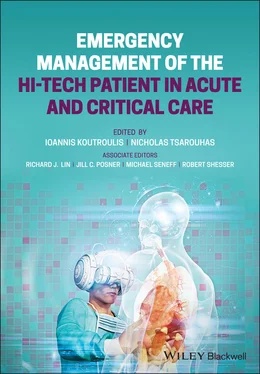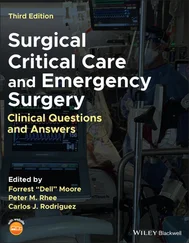In the event of portal hypertension, portal systemic collateral vessels form in order to bypass the obstruction. Increase in the blood flow through collateral vascularity can then lead to engorgement in gastroesophageal vessels to return to systemic circulation. Patients may develop esophageal varices that have an increased tendency to bleed when portal pressure rises. Other complications of portal hypertension include the development of ascites and progressive liver dysfunction.
The transjugular intrahepatic portosystemic shunt (TIPS) is an interventional radiology procedure where a stent is inserted to ameliorate the complications from portal hypertension.
The TIPS creates an artificial channel between the portal vein and the hepatic vein, thereby decreasing the resistance of blood flow returning to the systemic circulation. Placement of a TIPS is performed with interventional radiology.
Preferably, access occurs through the right internal jugular vein; however, the left internal jugular vein may be used as well. A vascular sheath is introduced and placed into the intrahepatic inferior vena cava. In most cases, the right hepatic vein is isolated and then the radiologist identifies the right portal vein. The shunt is introduced by cannulating the right portal vein from the right hepatic vein. Using the sheath introduced via the jugular access, a needle is passed into the right portal vein. Contrast is used to confirm placement of the needle tip. A wire is passed through the portal vein, and the fibrotic liver tissue is dilated with a small‐caliber balloon. A stent is passed over the wire between the hepatic vein and the portal vein, and as the original vascular sheath is withdrawn, the stent opens. It is then balloon dilated to an appropriate width based on measurements of portal venous pressure.
The TIPS device is used to combat the downstream effects of portal hypertension. Patients who have experienced esophageal variceal bleeding that has not been controlled via medical or endoscopic management may benefit from the insertion of a TIPS. Patients who have recurrent worsening ascites that is not improved with traditional medication and diet management also may be candidates for insertion. TIPS may be similarly beneficial in extravascular shifts causing hepatic hydrothorax refractory to medical management.
Hepatorenal syndrome occurs when cirrhotic changes of the liver lead to poor perfusion. Response of vasoactive hormones causes vasodilation of the splanchnic circulation and compensatory vasoconstriction of renal arteries leading to increasing renal failure. Some effect of fluid shifts of increased ascites may also play a role in renal hypoperfusion, and there is some suggestion that TIPS may reduce these shifts leading to improvement in renal function.
Given the increase in systemic circulation through the hepatic vein, which then returns to the heart via the inferior vena cava, patients with severe elevation in right heart pressures or pulmonary hypertension are not ideal patients to receive a TIPS. Similarly, patients with congestive heart failure should not experience the increased systemic return. Patients with active infections either systemically or within the liver should not receive TIPS. Finally, patients with concurrent bleeding diatheses should be corrected prior to the procedure.
Creation of a TIPS occurs with interventional radiology. Once the shunt device is in place, there is no further external equipment the patient requires.
Complications
Hepatic Encephalopathy
The liver processes toxins when blood is drained from the mesenteric system and filtered prior to returning to systemic circulation. Creation of a portosystemic shunt allows for the mixing of unfiltered intestinal blood into the hepatic vein. Hepatic encephalopathy occurs when unprocessed toxins are not removed effectively. Encephalopathy, if left untreated, may lead to patients progressing from mild confusion to altered levels of consciousness and even coma.
Most patients with portosystemic shunt related hepatic encephalopathy present two to three weeks after the TIPS procedure. Mild forms may be missed, as patients present initially with confusion and forgetfulness. Reversal in the sleep–wake pattern, with patients being awake at night and asleep during the day, is the first stage indicator of encephalopathy. Second stage may move to personality changes and worsening lethargy with altered consciousness. Severe encephalopathy can cause coma, seizures, and neurologic changes, including clonus and asterixis.
While encephalopathy may be noted after the initial TIPS procedure is performed, there are usually background causes that aggravate the symptoms. Episodes of esophageal bleeding, increased protein intake, worsening renal function, or constipation cause an increased gastrointestinal nitrogen load. Some medications or drugs of abuse (including alcohol) can be implicated. Patients who experience infection are at an increased risk of encephalopathy. Finally, many cases, up to 30%, have an unknown trigger.
Encephalopathy is a clinical diagnosis. While lab investigations may reveal elevation in liver enzymes and ammonia, there are no specific levels at which these tests are diagnostic. Most commonly, brain imaging does not show abnormalities. However, once the diagnosis of encephalopathy is suspected, investigation into the other attributing factors listed above may help with therapy.
Treatment of encephalopathy focuses on reversal of any of the secondary factors in combination with decreasing gut reabsorption of nitrogen waste products. Lactulose increases gut transit and may decrease production of nitrogen by intestinal bacteria. Addition of antibiotics, including rifaximin or metronidazole, also decreases intraluminal nitrogen production by decreasing intestinal bacterial load. Patients are encouraged to eat a nutritious diet with an appropriate amount of protein. Often, encephalopathy in patients with TIPS resolves spontaneously or with minimal change. In about 5% of patients with TIPS, if medical management of encephalopathy is not effective, the TIPS procedure may need to be reversed.
Clinicians need to consider stent infection in patients with a history of a TIPS procedure that present with intermittent or continuous fever. Most patients with vegetative infection present weeks to months after their TIPS, and infection may be related to clot formation or direct bacterial seeding (endotipsitis). Clinicians should assess with blood cultures from multiple sites and evaluation of the stent initially with Doppler ultrasound for the presence of stenosis or clot. In the absence of other etiologies for fever, patients should receive intravenous antibiotics targeted toward enteric organisms.
Worsening liver function due to the underlying liver disease can cause a decrease in hepatic production of clotting factors. Prior to TIPS insertion, assessment of coagulation panel should be performed and any bleeding diathesis corrected. Most patients who will experience bleeding as a complication to their TIPS insertion do so perioperatively, and it is not a common presentation to the emergency department.
Creation of a TIPS introduces a stent across hepatic tissue from the hepatic vein to the portal vein. Hepatic tissue reacts to this placement and begins to create a pseudo‐intima around and into the shunt. Increase in tissue into an uncoated stent begins to narrow the lumen of the stent and decrease the portosystemic blood flow, making the stent less effective. This then allows portal hypertension to recur, and patients have an increased risk in esophageal variceal bleeding and redevelopment of ascites.
Читать дальше












